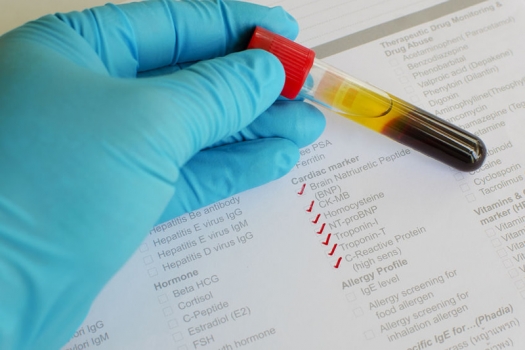CardiacMarkerTest.jpg

Photo by Jarun Ontakrai, ©2016 / 123rf.com
In this next article on cardiovascular health, I would like to share with you objective measurements that can be quite useful in assessing cardiovascular disease (CVD) risk. These are particularly important, because for most people, the first indication they receive that they have CVD is a heart attack or stroke. Many think that you can't tell if you have heart disease until you have "The Big One," but this is fortunately not so. I highly recommend, based on decades of clinical practice, trustworthy research and common sense, that you can take these steps to get an idea of what your real risk of CVD is. Prominently absent from this discussion of risk assessment is blood cholesterol, which is almost completely irrelevant and useless as a predictor of CVD risk. Please listen to my recent interview with Uffe Ravnskov, MD, PhD, on "Revealing the Cholesterol Myths."
So let's look at which tests matter most. This is important, because millions of people are living with either a false sense of security ("My cholesterol is low, so I'm fine"), or a false sense of concern ("My cholesterol is high, so I'm going to die of a heart attack"). Let's avoid both mistakes and do it right.
As established in earlier articles, the only reason you and I were told that cholesterol is bad, and a meaningful marker for CVD risk, was solely because there are drugs great at lowering it. The truly important tests are ignored by the medical establishment and mainstream media, simply because there are no drugs that affect those markers. The only things that get attention are those things that drugs can affect, regardless of how (in)significant they are. So here are the blood tests that can help:
Cardiovascular Risk Blood Analysis
Here are the tests that evidence and experience supports the use of (unlike cholesterol):
- Cardiac C-Reactive Protein
- Lipoprotein-associated phospholipase A2 (PLAC)
- Homocysteine
- Fibrinogen
- Lipoprotein (a)
- Fasting Insulin
- Triglycerides
Useful Blood Marker #1: High-Sensitivity or Cardiac-Reactive Protein
a.k.a. Cardiac CRP, Cardio CRP, High-Sensitivity C-Reactive Protein, CCRP, HS-CRP
Sample reference ranges:
- Optimal: below 1
- Small problem: 1-3
- Big problem: 4+
I think you and I are clear at this point that cholesterol is good and protective, and not the cause of cardiovascular disease (CVD). CVD is an inflammatory and nutritional deficiency condition. Inflammation in the blood vessels triggers a cascade of events that lead to the formation of artery-clogging plaque, which is made partly of cholesterol and calcium. Since inflammation in your blood vessels is the primary cause, wouldn't it be great to know how much inflammation you have in your arteries? You can, through two essential blood tests that measure how "hot" it is in there.
The first is a more sensitive version of the standard CRP test. Standard CRP tells you if there is inflammation or infection somewhere in the body, but not where. It measures a protein created by the liver in response to acute or chronic inflammation. It has been shown to be non-predictive of CVD risk. The more sensitive C-CRP is more specific to vascular inflammation, which is the main cause CVD.
Published studies
"Of the inflammatory markers evaluated by a CDC and American Heart Association (AHA) Panel in 2002, only C-reactive protein (CRP) met the analytical requirements for outpatient clinical use and, therefore, has been studied intensely over the past decade. More than 25 prospective epidemiologic studies have shown that CRP is a strong and independent predictor of future myocardial infarction, ischemic stroke, peripheral arterial disease, and sudden cardiac death in apparently healthy men and women."
Source: "High-Sensitivity C-Reactive Protein and Cardiac C-Reactive Protein Assays: Is There a Need to Differentiate?" Clinical Chemistry, July 2006 vol. 52 no. 7 1254-1256
The weakness of both tests (CRP and C-CRP) is their susceptibility to false positives. This means that they can be elevated for reasons other than (vascular) inflammation. For example, they can be elevated if, at the time you have your blood drawn, you have an active infection, recent trauma or injury, or recent surgery. Smoking or being overweight may also raise this marker, though obesity and smoking are also two major contributors to CVD. Overweight people often have insulin resistance, a major contributor to inflammation. Smokers are generally also chronically inflamed, from the toxicity, nutritional deficiencies and the direct heat caused by this deadly habit.
Case example
Mary was a 62-year old patient who came in for her first visit with blood work from her physician showing a CCRP of 15. She and her physician were very concerned. I asked her to think back to the day she had her blood drawn, and it turns out that she was in the middle of a bad flu, with a fever of 102, and had also fallen the day before and badly bruised her arm. I recommended she repeat the CCRP when she was uninjured and feeling fine, and the result was a slightly elevated 1.5.
Sample schedule
Adjust your schedule depending on your results (more often if high), and if you have a family history of CVD.
Age 18-40: every 3-5 years
Age 41-60: every 2 years
Age 61+: every year
What to do if CCRP is high?
This calls for the anti-inflammatory lifestyle, which includes:
- Regular exercise (one to four hours per week)
- Optimize your weight (especially eliminating belly fat)
- Avoid pro-inflammatory and otherwise detrimental foods, such as sugar, non-fermented soy, pasteurized milk, trans-fats (hydrogenated oils), artificial sweeteners and chemicals, etc.
- Assess your heavy metal toxicity with hair mineral analysis through Analytical Research Labs (health professionals can contact Gaeta Communications for more info). Heavy metals, or toxic elements, can be quite inflammatory. Work with a natural health professional trained in heavy metal detoxification protocols if elevated. Repeat hair analysis every three months until clean.
- Eat protective foods that can help reduce inflammation: a colorful diet of organic berries and vegetables, grass-fed beef, pastured poultry, raw dairy, organic eggs, and healthy fats such as olive and coconut.
- Work with a health professional to do a guided purification program. The one I use myself and with patients, which I consider the most natural and physiologically balanced, is the Standard Process Purification Program, which could be done once per year for three weeks, or twice per year for 10 days.
Supplements:
- I take and recommend Standard Process' Tuna Omega-3 Oil. This is a clean, sustainably-harvested, minimally-processed tuna oil that has no detectable PCBs, peroxides or mercury. I have had better results with this formula than others which provide larger doses of omega-3.
- Standard Process' Cyruta-Plus is a wonderful whole-food concentrate of organically-grown buckwheat leaf and seed. It is rich in bioflavonoids, vitamin C complex, and vitamin P (the "capillary fragility factor"). Buckwheat also improves insulin sensitivity, reduces elevated blood sugar, improves the integrity and elasticity of blood vessels. I often recommend this formula for folks with chronic or acute inflammation, weak blood vessels (varicose and spider veins, hemorrhoids, easy bruising), and elevated blood sugar or fasting insulin. (Source: "Effect of total flavones of buckwheat seed on lowering serum lipid, glucose and anti-lipid peroxidation." - Chinese Pharmacological Bulletin, June 2001. A physician colleague conducted an informal study in his clinic. He gave 352 patients with elevated C-CRP Cyruta-Plus for six months, then repeated the test. He had 100% success in lowering this important marker with Cyruta-Plus.)


